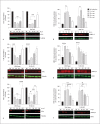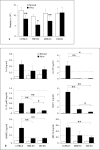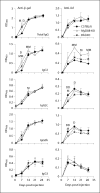TRIF, and TRIF-interacting TLRs differentially modulate several adenovirus vector-induced immune responses
- PMID: 20375595
- PMCID: PMC2853581
- DOI: 10.1159/000207194
TRIF, and TRIF-interacting TLRs differentially modulate several adenovirus vector-induced immune responses
Abstract
The use of Adenovirus (Ad)-based vectors has proven to be a useful platform for the development of gene therapy and vaccine protocols. The immunological mechanisms underlying these properties need to be identified and understood to foster safer, more efficacious use of this important gene transfer platform. Our recent studies have confirmed an important role for MyD88 dependent toll-like receptor (TLR) pathways as mediators of these responses. In this study, we confirm that TLR3, TLR4 and TRIF (TIR-domain-containing adapter-inducing interferon-beta) can also have augmentative or inhibitory roles during Ad-induced immune responses. Importantly, our studies revealed that TLR4 acts to suppress several aspects of the Ad-induced innate immune response, a finding not previously reported for this TLR in any model system. In addition, using MyD88 and TRIF double knockout mice, we demonstrate that the MyD88 and TRIF adaptor proteins can play either additive or redundant roles in mediating certain aspects of Ad vector-induced innate and adaptive immune responses. Furthering this complexity, our model system strongly suggests that non-TLR based systems must not only exist, but also have a significant role to play during Ad vector-mediated induction of adaptive immune responses.
Copyright 2009 S. Karger AG, Basel.
Figures





References
-
- Appledorn DM, Kiang A, McBride A, Jiang H, Seregin S, Scott JM, Stringer R, Kousa Y, Hoban M, Frank MM, Amalfitano A. Wild-type adenoviruses from groups A–F evoke unique innate immune responses, of which HAd3 and SAd23 are partially complement dependent. Gene Ther. 2008;15:885–901. - PubMed
-
- Jiang H, Wang Z, Serra D, Frank MM, Amalfitano A. Recombinant adenovirus vectors activate the alternative complement pathway, leading to the binding of human complement protein c3 independent of anti-ad antibodies. Mol Ther. 2004;10:1140–1142. - PubMed
-
- Kiang A, Hartman ZC, Everett RS, Serra D, Jiang H, Frank MM, Amalfitano A. Multiple innate inflammatory responses induced after systemic adenovirus vector delivery depend on a functional complement system. Mol Ther. 2006;14:588–598. - PubMed
-
- Appledorn DM, Patial S, McBride A, Godbehere S, Van Rooijen N, Parameswaran N, Amalfitano A. Adenovirus vector-induced innate inflammatory mediators, MAPK signaling, as well as adaptive immune responses are dependent upon both TLR2 and TLR9 in vivo. J Immunol. 2008;181:2134–2144. - PubMed
Publication types
MeSH terms
Substances
Grants and funding
LinkOut - more resources
Full Text Sources
Medical

